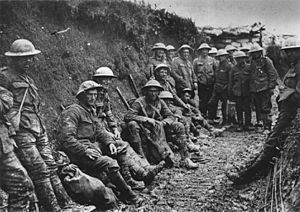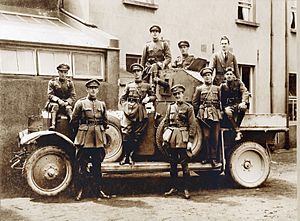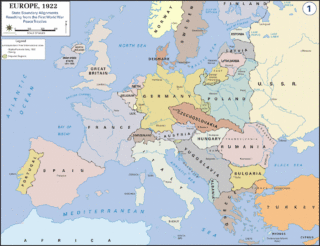History of County Wexford (1914–1923) facts for kids
County Wexford (Irish: Contae Loch Garman) is a county in the south-east of Ireland. The years between 1916 and 1923 were very difficult and important for the county. In 1914, Ireland was still part of the United Kingdom. During World War I, many war activities happened in County Wexford, especially in its coastal waters. Many men from County Wexford joined the British Army and died fighting in Europe. In 1916, rebels from Wexford took over the town of Enniscorthy during the Easter Rising. County Wexford was very active during the War of Independence and later saw a very tough Irish Civil War.
Contents
Enniscorthy in 1916
In 1916, a small rebellion, called a "rising," happened in Enniscorthy, just like the one in Dublin. On April 27, 1916, about 600 armed Irish patriots took over Enniscorthy town. They did this almost without anyone fighting back, in a surprise attack. Their leader was Robert Brennan (journalist). These rebels were mostly Irish Volunteers, joined by members of Fianna Éireann (a youth group) and Cumann na mBan (a women's organization).
The patriots made the Athenaeum Theatre their main base. They took control of the town, blocking roads and the railway line. They surrounded the barracks of the R.I.C. (the police force at the time). Shots were fired, but they didn't try to capture the barracks. The British government sent over 1,000 soldiers to take back Enniscorthy.
On April 29, 1916, news reached Enniscorthy that the main rebellion in Dublin had ended. The rebels in Enniscorthy didn't believe it. They refused to give up unless Patrick Pearse, one of the Dublin leaders, ordered them to. The next day, two of their leaders went to Dublin to speak with Pearse in prison. Pearse gave the order to surrender. So, on May 1, 1916, the Enniscorthy patriots gave up without conditions. No one was killed, and there wasn't much damage to buildings. Some leaders, like Robert Brennan, were sentenced to death, but their sentences were changed. About 270 people were arrested, and 150 of them were sent to a prison camp called Frongoch internment camp in Wales. This camp used to hold German prisoners of war.
Michael O'Hanrahan from New Ross, who was part of the Easter Rising in Dublin, was sadly executed on May 4, 1916.
World War I and Wexford's Coast

During World War I, many men from County Wexford fought and died in Europe. Local newspapers often showed sad notices about those who died. Ireland was still under British rule during the war. At least 504 men from County Wexford who joined the British Army died fighting on land.
German U-boats (submarines) were very active near Wexford's southern coast. British airships were based at Johnstown Castle to try and stop the U-boats, but they didn't have much success at first. Later, from February 1918, American seaplanes from United States Naval Air Station Wexford helped clear the shipping lanes (main sea routes) of U-boats quickly.
One famous U-boat, U-20, sank two ships off Wexford's coast in May 1915. The next day, this same U-boat famously sank the large passenger ship RMS Lusitania off County Cork. This terrible event killed 1,198 people, including many Americans, which helped lead to the United States joining the war. Many ships were sunk off Wexford's coasts during the war, especially in 1915 and 1917. The sea area around Tuskar Rock became known as "The Graveyard" because so many Allied ships were sunk there.
Some German U-boats were also sunk in Wexford's waters. For example, SM UC-44 was sunk by a mine near the Hook Peninsula in August 1917. Only its commander survived. Another U-boat, SM UC-33, was sunk by a British patrol boat off Tuskar Rock in September 1917, with only one survivor.
John Redmond's Death and the First Dáil
John Redmond, who led the Irish Parliamentary Party, died in London on March 6, 1918. He was buried in Wexford later that month. Many people attended his funeral. After the Easter Rising, public opinion in Ireland changed a lot. Redmond's party lost much of its support.
In the 1918 General Election, Sinn Féin (an Irish nationalist party) won 73 out of 105 seats in Ireland, replacing Redmond's party. County Wexford elected two Sinn Féin candidates. However, Sinn Féin refused to take their seats in the British Parliament in London. Instead, they set up their own Irish Parliament, called Dáil Éireann, in Dublin. It met for the first time on January 21, 1919. Only Sinn Féin members attended, as many others were in prison.
The Dáil elected Éamon de Valera as President of the Republic. The Dáil also created a Department of Defence, which was represented by the Irish Republican Army (I.R.A.). Michael Collins and Cathal Brugha were key leaders of the I.R.A. World War I ended in November 1918. But while peace came to Europe, difficult times were ahead for Ireland and County Wexford. On the same day the First Dáil met, the Irish War of Independence began.
Irish War of Independence (1919–1921) and the Treaty
The Irish War of Independence (1919–1921) was fought by the I.R.A. to end British rule and create an independent Irish state. It was a guerrilla war, meaning small groups used surprise attacks and quick retreats. Although County Wexford didn't see as much fighting as some other parts of Ireland, it was still very involved.
In Wexford, many Royal Irish Constabulary (R.I.C.) barracks (police stations) were attacked, burned, or destroyed. This happened in places like Clonroche, Ferns, and Gorey. Some attacks were done to get weapons. Many R.I.C. barracks were abandoned because the police couldn't defend them. The police then moved to larger towns where they could protect themselves better.
Post Offices were also attacked, and there were some attacks on the railways. The British brought in a new, often harsh, police force called the Black and Tans to deal with the I.R.A. They raided homes, burned property, and carried out ambushes. The Black and Tans became very unpopular because of their cruel actions. Even the British King, George V, was angry about what they did. Many people were arrested and mistreated, and some went on hunger strike.
One of the most well-known deaths in Wexford during the war was that of Percival Lea-Wilson, an R.I.C. officer in Gorey. He was shot dead by the I.R.A. outside his home on June 15, 1920. This was ordered by Michael Collins, who believed Lea-Wilson had mistreated prisoners after the Easter Rising. Lea-Wilson is even shown in the movie Michael Collins. Years later, his widow donated a famous painting, The Taking of Christ, to a religious order in Dublin.
The most people killed in one event in Wexford during the war happened on October 12, 1920. Five men died and many more were injured when explosives accidentally blew up in an old house at St. Kearns, Saltmills. A monument was later built there to remember them.
On January 4, 1921, County Wexford was placed under Martial law, meaning the military took control. The Irish War of Independence ended on July 11, 1921, when both sides agreed to a truce.
After the Anglo-Irish Treaty was signed on December 6, 1921, and approved in January 1922, twenty-six of Ireland's thirty-two counties formed the Irish Free State. This included County Wexford. Six northern counties chose to remain part of the British state. From 1922 onwards, the area now known as the Republic of Ireland became self-governing.
However, some parts of the Treaty were very unpopular. The I.R.A. split into two groups: those who supported the Treaty (pro-Treaty) and those who opposed it (anti-Treaty). The pro-Treaty side formed the government and controlled the Free State Army. Those against the Treaty refused to join the new government and started a war against the Free State forces. This was the Irish Civil War (1922–1923). The anti-Treaty side is often called Republicans or the anti-Treaty I.R.A.
Michael Collins, a key leader, visited Wexford town in April 1922. He stayed at the Talbot Hotel and gave a speech to a large crowd. During his speech, Collins said that the most important thing was the British troops leaving Ireland, which would make Ireland free. He warned against division and civil war among the Irish people.
Irish Civil War (1922–1923)
The Irish Civil War began on June 28, 1922. In April 1922, a group of anti-Treaty I.R.A. members had taken over the Four Courts building in Dublin. On June 28, Collins ordered the Free State Army to attack the Four Courts with artillery. This was the start of the Civil War. The Four Courts building was largely destroyed, along with many important historical documents.
After the Four Courts fell, the Free State Army sent a group called the Wexford Column to control the south-eastern coast. This group had 230 men and armored cars. They took Gorey and then moved to Enniscorthy, where they faced strong resistance. The anti-Treaty forces fought them from Enniscorthy Castle. After three days of fighting, the Free State Army took the town. A part of the column then went to Wexford town, where they met little resistance and set up their headquarters at the Talbot Hotel.

County Wexford was heavily involved in the Civil War, which was also a guerrilla war. Many people on both sides lost their lives. Many large houses were burned and destroyed, like Castleboro House and Wilton, often because they were used to house Free State troops.
The I.R.A. in County Wexford was divided by the Treaty. The North Wexford I.R.A. supported the Treaty, while the South Wexford I.R.A. opposed it. These two groups, who had fought together in the War of Independence, now fought each other. Historians say that Wexford saw more fighting during the Civil War than during the War of Independence.
At first, the anti-Treaty forces controlled all of Wexford, including Wexford town, Gorey, and Enniscorthy. The Free State Army eventually pushed them out. But the anti-Treaty groups continued to fight, ambushing transports, attacking barracks, and blowing up bridges. This led to a cycle of revenge killings and executions.
The anti-Treaty I.R.A. in Wexford often attacked the county's railway network. This was known as the 'War on the Railways'. They did this to make it impossible for the new Free State government to operate.
On July 24, 1922, an anti-Treaty I.R.A. unit ambushed a train near Killurin Railway Station. They were trying to free prisoners being taken to Dublin. They fired at the carriages with Free State soldiers. Three Free State soldiers were killed, but the attempt to free prisoners failed. On October 10, 1922, a Free State army officer, Commandant Peter Doyle, was shot dead by anti-Treaty I.R.A. in Enniscorthy. Five girls were also hurt.
In March 1923, three anti-Treaty I.R.A. prisoners were executed by the Free State side in Wexford Jail. They were James Parle, John Creane, and Patrick Hogan. They had been arrested for having firearms. James Parle was a leader in an anti-Treaty I.R.A. unit called the Kyle Flying Column. The next day, three Free State soldiers were taken from a pub in Adamstown and shot dead. This was a revenge killing for the executions of Parle, Creane, and Hogan. The day after that, Free State soldiers shot Michael Furlong, suspecting him of being an anti-Treaty I.R.A. member.
The anti-Treaty side declared a ceasefire across the country on April 30, 1923. On May 24, 1923, the war ended when anti-Treaty I.R.A. units were ordered to give up their weapons, which most of them did. The Free State side had won. After this, normal political life slowly returned to Ireland.
|


